Philanthropist or remorseful millionaire? Who was Andrew Carnegie and how did he become one of America's richest people in 19th century?
Andrew Carnegie was born in 1835 in the Scottish town of Dunfermline, where his father had a weaving workshop with three manual workshops. When steam mills became operational, manual production turned out to be unprofitable and the specter of poverty caught the eyes of the family. Old Carnegie decided to get on a ship with his relatives and go to the "promised land" of the world's poor - America. There they settled in the then center of the textile industry, the city of Allegheny in Pennsylvania (now a suburb of Pittsburgh).
Thirteen-year-old Andrew, instead of going to school, had to earn a living. He was hired as a boy to help at a clothing factory in nearby Pittsburgh. He worked there six days a week, 12 hours a day, earning just $ 1.20 a week. On Sundays, he went to a school where he learned to read and write.
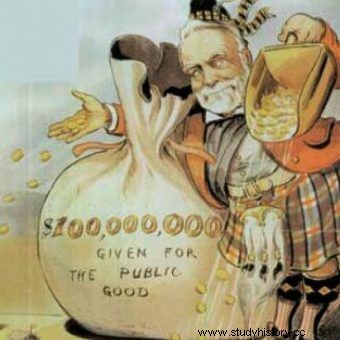
Philanthropist or remorseful millionaire? Who was Andrew Carnegie, and how did he become one of America's richest people in 19th century? Pictured is a caricature from Louis Dalrymple of Carnegie ("Puck" magazine 1903).
Apparently, when a teacher once asked him about his favorite quotation from the Bible, young Carnegie replied without hesitation:" Take care of your pennies, because your thalers will not take care of themselves ". Although it was not a true Scriptural quote, it did show where the boy chose to direct his life. Money became the target.
He read telegrams by ear
From the spinning mill, Andrew moved to the telegraph equipment factory, where he looked after a small steam engine. The work was hard, the working hours were long, but the boy put all his attention into it and dreamed of becoming a telegraphist. Some time later, he was accepted into the Ohio Telegraph Company telegraph office in Pittsburgh as a messenger to deliver messages. It was like grabbing God by the legs:instead of many hours of hard work on factory machines, a clean office filled with paper, books and pens. Plus a higher salary - $ 2.50 a week.

When the Carnegie family decided to immigrate to the United States, Andrew was only 12 years old. He started working right away - first in a cotton mill, and then he became a telegram distributor. Pictured with Brother Thomas.
Andrew was especially committed to his new job. He memorized a Pittsburgh address guide to spread messages quickly. He had become so practiced that he listed offices, shops and factories on a given street by number on request. In the mornings and evenings, he learned to telegraph, and he also made extra money by rewriting messages for local newspapers. He soon acquired such experience that he could read telegrams broadcasted by Morsem by ear, and he could also operate a telegraph machine on his own. His superiors appreciated his abilities and promoted him to telegraphist. Andrew's first short-term goal has been achieved.
From worker clerk, from investor clerk
Thomas A. Scott, one of the directors of the Pennsylvania Railroad Company, spotted the young Carnegie's telegraph office. Surprised by the intelligence and energy of the boy, he hired him as an assistant telegraphist with a salary - a trifle - $ 35 a month. Andrew soon became Scott's trusted official. So much so that, after several months of work, the director advised him to invest $ 500 in the shares of the Adams Express Society, which deals with the delivery of large mail.
Andrew, however, did not have as much sum as he could. His parents came to his aid by borrowing $ 500 for a small house mortgage to enable his son to make an investment. Carnegie bought stocks and became a capitalist. Imagine his surprise when, after some time, the Society paid out the first dividend - 12 percent a year on capital, so much more than what he managed to earn by working all day.
From poverty to money
Thanks to Scott's backing, but also his own abilities, Andrew became the manager of the Pennsylvania Railroad in Pittsburgh. It was then that he also started investing in various projects related to rail transport and industry.
The experience and knowledge he gained in the PRC meant that after the outbreak of the Civil War, he received a proposal from the War Department to take the position of managing the military telegraph network. By the way, he dealt with the supply of rails for the army and the transport of weapons, equipment and ammunition, thanks to which he obtained funds for further investments . After two years of state service, he returned to Pittsburgh. And it was there that he realized one of the best interests of his life.
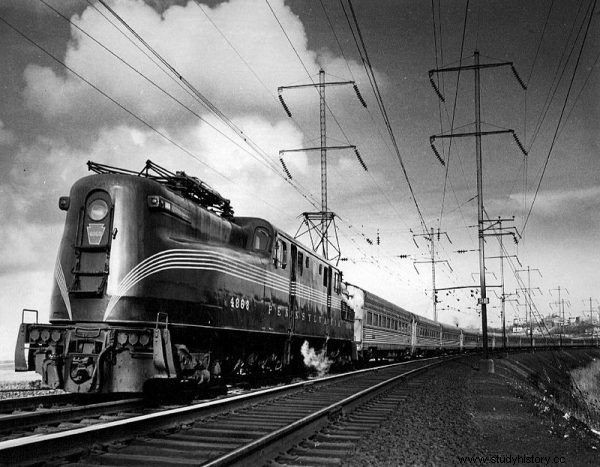
The Pennsylvania Railroad Company, the American class I railroad, was established in 1846. Over the years, it merged with around 800 other companies' railroads, becoming the world's largest publicly traded corporation at the time, with a budget larger than the US budget! No wonder Carnegie grew rich quickly as a participant in the venture.
Thirty-year-old millionaire
One day an inconspicuous man named Theodore T. Woodruff showed up at the Carnegie office. He presented the plans for his invention - a wagon with sleeping places. Andrew immediately realized that this was a great opportunity for him. The railway was then an industry that was developing dynamically, and the demand for its connections in large areas of the USA was increasing more and more. Facilitating travel by allowing passengers to sleep as comfortably as possible at night could bring enormous profits to the originator and sponsor.
Carnegie borrowed money and entered into partnership with the inventor. When the Woodruff Sleeping Car Company produced the first sleeper cars, Andrew also introduced them to the Pennsylvania Railroad. The invention revolutionized US travel. The businessman's second "bull's eye" was to invest in oil sources discovered near Pittsburgh. Andrew and several friends combined capital and purchased one of them for $ 40,000. How brilliant the idea was, it turned out very quickly: the exploitation of the source generated a million dollars in income in a year and the value of the company reached 5 million!
At 30, Carnegie became a millionaire. In the nineteenth century sense, because today a million in 1900 would be worth over $ 200 million.
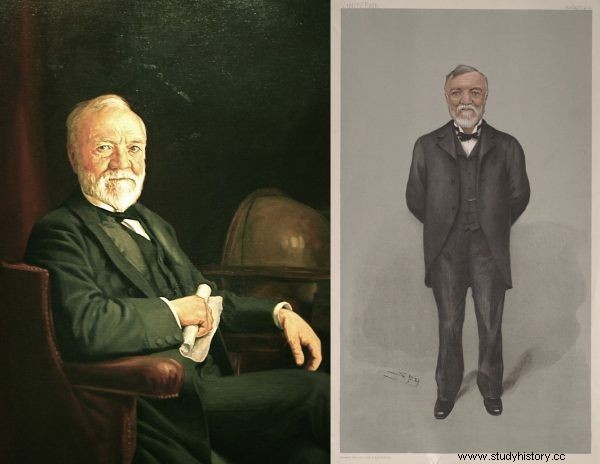
Thirty-year-old millionaire? This was not a common phenomenon in the 19th century. That is why the figure of Andrew Carnegie often appeared in public space, both in paintings (left - artist unknown) and caricatures (right by Leslie Ward, "Vanity Fair").
Steel tycoon
The third industry Carnegie invested in was the steel industry. While working for the Pennsylvania Railroad Company, he began buying stocks of steel companies. The demand for steel in the United States recovering from the Civil War was enormous, so companies were too, very successful and profitable. All this led Carnegie to leave PRC in 1865 and start his own business, focusing on steel production.
He made another business of his life by combining steel production and railroads. When the Pennsylvania Railroad began replacing the bridges on its routes from wood to iron, Carnegie won a contract to implement the project. He invested in the Keystone Brigde Company iron bridge factory and began profitably supplying them to the railroads - first in Pennsylvania and then throughout the United States. It is worth mentioning that these bridges still stand in the USA today and are entered in the register of monuments.
As he traveled through Europe, Carnegie made sure that the demand for steel continued to grow. Therefore, he invested in steel mills and steel plants, as well as related industries, such as coal and ore mines. In 1883 he purchased one of the largest steel plants in the country - Homestead Works. Then he bought a company importing coke to the USA. He placed his plants near the Great Lakes, where he built a flotilla of ships to transport raw materials and finished steel products to large cities:New York, Detroit and Chicago. In 1892, he merged three of his largest steel mills into a concern under the name Carnegie Steel Company. He built bridges, ships, wagons, locomotives, armaments and made money on that fortune. He was the richest man in the world at the end of the 19th century.
Capitalist bloodsucker
Carnegie made his millions ruthlessly. The workers in his factories worked 12 hours a day, seven days a week. They were entitled to free leave only once a year - on July 4, during the Independence Day. He forced the threat to reduce salaries to maintain efficiency. He required managers to constantly raise the level of production. He suppressed protests and strikes without mercy. He employed immigrants from Europe because they worked 14 hours a day at a rate four times lower than American workers .
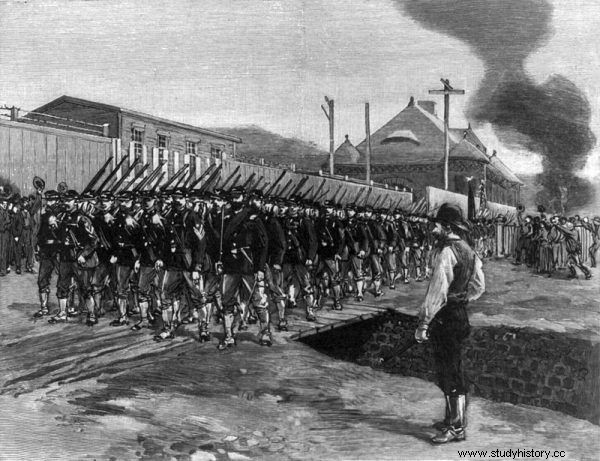
In 1892, a strike broke out in the company's largest steel plant, Homstead Works, as a result of a reduction in employee wages. There were riots in which 9 people were killed and over 100 injured. Carnegie was on vacation in Scotland at the time and dismissed the whole thing in silence ... Pictured is a picture that appeared in Harper's Weekly at the time, showing Pinkerton's bodyguards sent to quell the strike.
When a wage cut strike broke out at the Homestead Works in 1892, Carnegie refused to talk to any trade unions. He brought in scabs and armed bodyguards from the Pinkerton Agency. There were fights between agents and strikers, in which nine workers were killed and over 100 people were injured. Order was restored by the state militia. Workers returned to work on worse conditions ... Carnegie turned out to be a follower of the theory of Herbert Spencer, an advocate of an extreme form of social Darwinism, who proclaimed:
A society develops when its most talented members can establish their position freely, and the nature's least endowed no one tries to artificially keep them alive > .
The specific philanthropist
In 1900, at the age of 65, Andrew Carnegie sold his steel company to another industrial tycoon, J.P. Morgan. For this he received a huge sum then (and also today) - 480 million dollars. This amount, in terms of today's currency value, amounts to even more than $ 100 billion.
He devoted the rest of his life to philanthropic work and giving away his fortune. It was part of his life philosophy. It argued that:
(...) running a business makes no sense as long as it doesn't serve the public. Man cannot have any gods before him, and the accumulation of wealth is one of the worst kinds of idolatry. There is no idol more degrading to man than money .
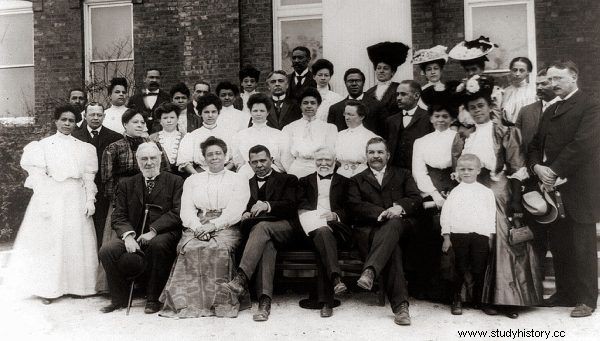
Suddenly, in 1901, Carnegie decided to retire. He was then considered the greatest rich man in the world. He then stated that rich people should surrender their surplus fortunes because "a man who dies rich dies disgraced." Pictured during a visit to the Tuskegee Institute (educating African Americans), of which he was a benefactor (1903).
Indeed, by his death in 1919, he had given away $ 350 million. He funded 2,500 libraries and many music rooms, including the famous Carnegie Hall in New York. He supplied organs for nearly 8,000 churches. He founded Carnegie Mellon University and the Carnegie Institution, supporting research in physics and biology. He created Carnegie Endowment for International Peace - an institution dealing with international conflict resolution. He funded the Peace Palace in The Hague, which today is the seat of the International Court of Justice.
As a philanthropist, however, he remained true to his belief that nothing in life is for free. The money was spent on cultural and scientific institutions, and not on helping individual people, because he considered it a waste of funds. When he opened a library he had funded in Pittsburgh in 1895, criticized entrepreneurs raising wages for their workers. He considered it a waste of goods that workers would eat or drink anyway without any use ...
***
The extraordinary story of a young and ambitious immigrant who came to 19th-century America in search of a better life was presented by Marie Benedict in her latest novel, The Billionaire's Maid. Clara Kelley of the richest man's maid in the US, Andrew Carnegie, becomes his secret advisor over time.
Bibliography :
- Andrew Carnegie, Autobiography of Andrew Carnegie , Constable and Co, London 1920.
- Andrew Carnegie, State of Interest , Gebethner i Wolff, Warsaw 1904.
- Krzysztof Osiejuk, Andrew Carnegie - business philosopher , "The Art of Ownership", April 17–23, 2015.
- James A. MacKay, Little Boss:A Life of Andrew Carnegie , Mainstream Books, Edinburgh 1997.
- David Nasaw, Andrew Carnegie , Penguin Press, New York 2006.
